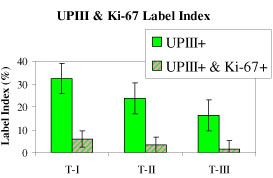Examples of Eric Kurzrock's Research

Images of rat bladders after transplantation of male bladder into female host.
A. Fluorescent in situ hybridization (FISH) of rat Y-specific chromosome probe on female control bladder demonstrating no stain.
B. FISH of Y probe on male bladder graft urothelium16 months after transplantation.
C. FISH of Y probe on male bladder graft muscle 16 months after transplantation.
D. FISH of rat X-specific chromosome probe on male bladder graft urothelium 16 months after transplantation (white arrows demonstrate double XX signal in female cells and green arrow demonstrates 3 X-signals overlying 2 nuclei).
Photographs taken with 60x oil immersion objective, B-D cropped and magnified 2x to demonstrate the probes.
Three Clonal Types of Urothelium with Different Capacities for Replication
Figure: ABC fluorescents
Figure: Chart
(A-C) Ki-67 and uroplakin (UP) III double immunofluorescent staining of porcine urothelial colonies, T-I, T-II and T-III, (10X, 20X and 20X), respectively. UPIII expression (green cytoplasm) indicates terminal differentiation of the cell. Ki-67+ staining (pink nucleus) indicates active proliferation, DAPI counter stain (blue nucleus). Bar diagram illustrates T-I colonies had a higher prevalence of terminally differentiated (UPIII+) cells than T-II and T-III colonies (values are means ± SD) (p-value < 0.05). Less than 6% of the cells in all colony types demonstrated simultaneous Ki-67 and UPIII staining (hatched bar).
Label-Retaining Cells of the Bladder: Candidate Urothelial Stem Cells
Figure 1
Figure 1. Rats were administered BrdU for 4 consecutive days at 6 weeks of age. Animals were euthanized at different time points post-injection. Anti-BrdU staining (DAB-brown) demonstrates LRCs at (A) 1 month (20X), (B) 6 months (40X), and (C) 12 months (60X) after BrdU administration. Inset box in (C) is magnified (5X) in (D) demonstrating the LRC atop the basement membrane (arrow). These findings are representative of 45 animals evaluated. Counter stains - hematoxylin (A,C) and methyl green (B).
Figure 5
Figure 5. Representative flow cytometry plots of urothelial cells stained against β4-integrin and BrdU. (A) negative control animal without exposure to BrdU. (B-D) three animals 1 year post BrdU labeling. Within the LRC population over 90% of the cells were β4-integrin bright (red arrow).

